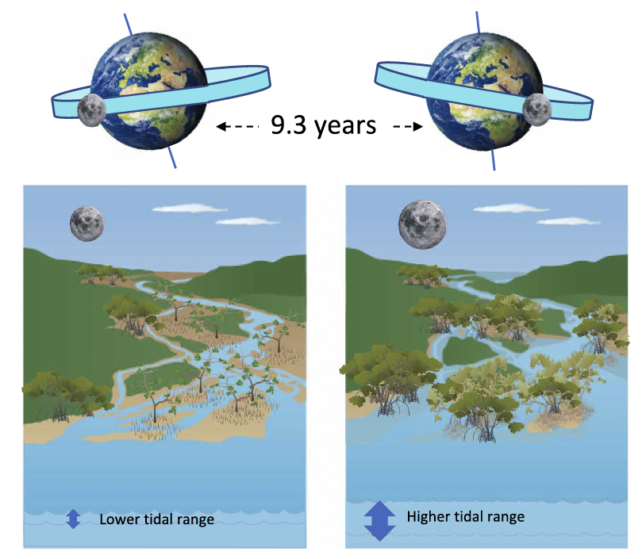The Moon's gravitational pull on our planet's tides is just one of Earth's many steady thrums of life.
Now researchers have found that lunar cycles not only synchronize the timing of animal migrations and mass spawning of corals but may also influence fluctuations in mangrove canopy cover.
Given the growing interest in mangroves as natural carbon sinks, the study findings could improve our understanding of how much carbon mangrove ecosystems are likely to draw down and sequester in the coming decades.
Understanding the seemingly strange connection between lunar cycles, tides, and mangrove growth might also give advanced warning of their vulnerability to severe droughts.
Led by wetland ecologist Neil Saintilan of Macquarie University, the team of researchers measured mangrove canopy cover across the entire Australian continent using a new batch of high-resolution satellite images taken between 1987 and 2020.
Digging into the data, researchers found a surprising fluctuation in mangrove canopy cover.
Just as the Moon tugs tides back and forth – tides that lap the roots of coastal mangroves – long-term oscillations in the lunar orbit also affect the growth patterns of these salt-tolerant trees that occupy gently sloping intertidal mudflats, the study found.
Called the 'lunar wobble', this cycle swings around every 18.61 years, pulling low tides lower and pushing high tides higher in two distinct phases, around 9.3 years long.
This wobble, the analysis reveals, appears to be a dominant factor controlling the expansion and contraction of mangrove canopy cover over much of the Australian continent.
"Until now, we haven't had the length of annual records at an appropriate scale to see these patterns," Saintilan told ScienceAlert, referring to the dataset used.
"When we plotted the trend in annual canopy cover over time, that's when we noticed a really interesting oscillation on an approximate 18-year cycle."
Fortunately, Saintilan had heard of the lunar wobble after NASA scientists showed in 2021 how its next phase was set to cause a surge in coastal flooding. He put two and two together, and the team uncovered what looked like a strong connection between lunar cycles and mangrove canopies.
"When we looked in detail at the timing of the peaks and troughs of the lunar cycle, it matched perfectly with changes in mangrove canopy cover – one of those 'Eureka!' moments you get a few times in your career," he says.
When the lunar wobble is in its minimum phase, the researchers figured that mangrove ecosystems would be sucked dry, experiencing fewer days where their roots were saturated and greater water stress, leading to thinner canopy cover.
At its maximum, the lunar wobble might thrust tides higher, boosting mangrove growth.

The synchronicity between the lunar wobble and mangrove canopy cover stood out against a backdrop of steady climate change, whereby higher air temperatures, sea levels, and CO2 levels are associated with mangrove expansion and canopy thickening.
That's not all. The team discovered these factors of lunar cycles and daily tides also interact with other climatic events such as the El Niño-Southern Oscillation, which influences alternating periods of heavy rainfall and prolonged droughts in eastern Australia and the western coasts of North and South America.
For instance, when some 40 million mangroves shriveled up and died in the Gulf of Carpentaria in northern Australia in 2015 – the largest mangrove dieback in recorded history – an intense El Niño coincided with a lunar wobble minimum, the researchers found.
This goes some way towards explaining why the Gulf suffered greater mangrove loss than adjacent regions, the researchers posit.
Not only did extremely dry weather from the intense El Niño event see average sea levels in the Gulf plunge 40 centimeters (16 inches), the trough in the lunar cycle pulled tides even lower, meaning vast areas of mangroves were thirsting for water.
The analysis showed that mangrove dieback was also most pronounced in mudflats fringing coastlines and river channels, areas subject to the full range of tidal extremes, adding weight to the researchers' conclusions.
"Observations from the 2015 dieback event suggest that the gray mangrove Avicennia marina is particularly susceptible to canopy decline under reduced inundation," Saintilan and colleagues write.
Given that A. marina is the most widely distributed mangrove species in Australia, "this may explain the consistency of the nodal cycle influence on mangrove canopy cover across the continent," they add.
Studies like this are important for teasing out the Earth's natural rhythms, and this one, in particular, could seed future research looking at whether mangroves' ability to soak up and store carbon in their sodden soils also changes with lunar cycles the way mangrove canopy cover does.
That'll be important to understand in detail as the world grapples with how to pull carbon dioxide out of the atmosphere to reverse global heating.
Protecting mighty mangroves is but one strategy at our fingertips. But there's a limit to what these resilient, adaptable plants can tolerate, as they are pushed landward by rising sea levels. So we best move fast.
The research was published in Science Advances.
